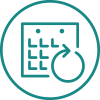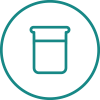
HbA1c

HbA1c
Purpose:
HbA1c is used for both the diagnosis (Type 2) and monitoring of diabetes (Type 1 & 2) and as part of the NHS England Health Check for subjects that on initial screen are identified as having a risk of developing diabetes.
The diagnosis of diabetes is based on the measurement of plasma glucose or glycated haemoglobin (HbA1c), with a cut off value for HbA1c of 48 mmol/mol used as the diagnostic threshold for diabetes; however, plasma glucose remains the preferred test in people with symptoms who are suspected of having type 1. Diagnosis and management of type 2 diabetes (HEARTS-D). Geneva]: World Health Organization; 2020 (WHO/UCN/NCD/20.1).
HbA1c is commonly used to monitor glycaemic control in both Type 1 and Type 2 diabetes as it provides a measure of average plasma glucose over the preceding 8 – 12 weeks.
Recommendations: HbA1c targets and monitoring
- HbA1c should be measured using methods calibrated according to International Federation of Clinical Chemistry (IFCC) standardisation.
- Children and young people with type 1 diabetes – HbA1c target level of 48 mmol/mol or lower will minimise risk of long-term complications.
- Children and young people with type 1 diabetes who have an HbA1c level above 48 mmol/mol that any reduction in HbA1c level reduces their risk of long-term complications.
- HbA1c should be measured 4 times a year in children and young people with type 1 diabetes.
- Diabetes services should document the proportion of children and young people with type 1 diabetes who achieve an HbA1c level of 53 mmol/mol or lower.
Recommendations: HbA1c measurement and targets
- HbA1c levels in adults with type 2 diabetes should be measured every: 3 to 6 months (tailored to individual needs) until HbA1c is stable on unchanging therapy or 6 months once the HbA1c level and blood glucose lowering therapy are stable.
- HbA1c should be measured using methods calibrated according to IFCC standardisation.
- NICE has produced a patient decision aid on agreeing HbA1c targets, which also covers factors to weigh up when discussing HbA1c targets with patients.
- For adults whose type 2 diabetes is managed either by lifestyle and diet, or lifestyle and diet combined with a single drug not associated with hypoglycaemia, aim for an HbA1c level of 48 mmol/mol. For adults on a drug associated with hypoglycaemia, aim for an HbA1c level of 53 mmol/mol.
- In adults with type 2 diabetes, if HbA1c levels are not adequately controlled by a single drug and rise to 58 mmol/mol or higher: reinforce advice about diet, lifestyle and adherence to drug treatment and support the person to aim for an HbA1c level of 53 mmol/mol and intensify drug treatment.
Scope:
The programme aim is to cover the clinically relevant ranges, encompassing the diagnostic cut-off level, of 48mmol/mol Hb for the diagnosis of diabetes. However, the analytical measuring range will also be assessed where appropriate. The programme is suitable for all Laboratory and POCT applications.
Fresh EDTA whole blood from individual diabetic patients and healthy volunteers are distributed monthly/bi-monthly. These samples reflect the wide range of HbA1c seen in healthy individuals and in Diabetic patients. Challenging samples from patients with known Hb variants are also distributed to assess current practice. Samples from volunteers and diabetic patients are distributed to ensure that the concentration range is appropriate for population health check screening, diabetes diagnosis and diabetes patient monitoring.
The HbA1c reference target values in the Weqas programme are assigned using IFCC secondary reference methods in an IFCC network laboratory. The programme allows for the assessment of the organisation’s and method’s performance, including linearity, trueness, bias, and imprecision.
 |
Key Features:
|
| HbA1c Programme | ||
|---|---|---|
| Analyte | Approx. Range Covered | |
| *HbA1c | 32 - 85 | mmol/mol Hb |
* IFCC and NGSP values assigned by the European Reference Laboratory for Glycohaemoglobin.
Related Documents








